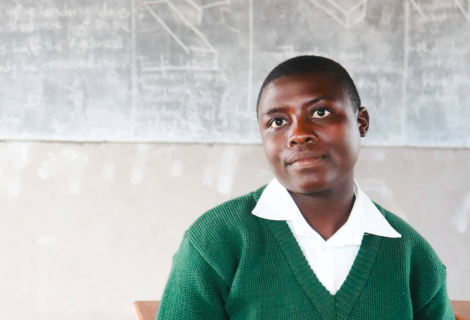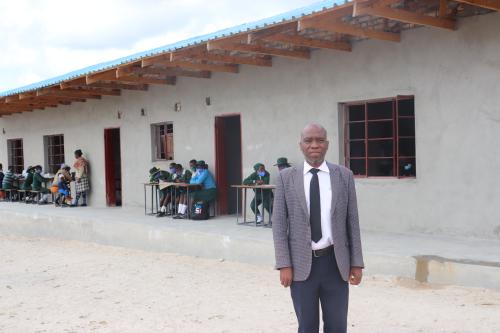Investing in girls’ education: the story of Yollanda

“Before the construction of the new school, I had to walk about 8-10 kilometres every day to the nearest and affordable school,” said Yollanda (19). “Sometimes I would miss my classes because I was tired and had no time to do my homework since I would always get home late. Learners were affected by the changing weather patterns, such as rain, wind, and cold, and we could not have daily lessons as we were learning in a makeshift school structure which has since been blown away,” she explained.
Children in Samanyika, Ward 13 of Nyanga District in Manicaland Province in Zimbabwe used to travel at most 15 kilometres to the nearest affordable secondary school as their parents and guardians could not afford to send them to the nearest boarding school. This is due to school fees for boarding scholars being three times more expensive compared to the day schools in other surrounding wards. This situation affects girls in particular because they frequently assist their families with care work before and after school. Despite performing well at primary level, the long walking distances, in combination with the gender expectations in the household and the involvement of young girls in taking care of the house and the members of their family, have been contributing to low pass rates amongst girls, as they often lack the time to concentrate on their homework or attend school regularly.
Yollanda is amongst the school children who travel long distances to reach the nearest affordable school, as her parents and guardians cannot afford the school fees of the boarding schools. She lives with her maternal grandparents, and she does all the care work before and after school, including taking care of her cousin brothers and her younger sister. “I wake up at around 5 am. I boil water and prepare food for my young sister and cousin brothers. My cousin brothers who study at Regina high school wake up at around 6am when water for bathing is ready. Once I have completed the chores, I then walk to school at 7am.” Yollanda said.
The lack of affordable nearby schools made it challenging for children, particularly girls, to attend classes. The long distances which often led to girls being exposed to risky sexual behaviour and abuse gave rise in teenage pregnancies and resulted in an increase in school dropouts. Additionally, gender stereotypes and patriarchal ideas that place women and girls in an inferior position are also often linked to school dropouts for girls, as in case their families could not afford school fees for all their children, girls would be the ones not to complete their education.
The construction of Nyambubarawande Secondary School as a satellite school by DOMCCP in partnership with ActionAid Zimbabwe in 2015 aimed at addressing the challenges that children were facing and reducing the distance they had to cover to attend school. As a result of Cyclone Idai in 2019, the makeshift school structure was blown away. In 2020, a two-classroom block was built under devolution funds led by ActionAid Zimbabwe and DOMCCP, which also provided transport to carry appropriate materials to build the school. For the teachers’ house that did not exist before, the Youth Build Zimbabwe initiative gathered 18 young volunteers who built the teachers’ house and were trained in building skills. Most youth could not access vocational training services before since they were too far and could not afford them. AAZ and DOMCCP covered the expenses of the trainer and trainees and organised as well as financed the training of Gender-Responsive Public Services trainers. The initiative was welcomed by the community and helped them address issues such as the community role in public services and child marriage, to a name a few.
As a result of the building of Nyamubarawande Secondary School, there has been an increase in school enrolment, the majority of which are girls, and a reduction of the number of child marriages in the area. “The community and the school are now working towards a total end of child marriages,” said Masimba Nyabereka, the Headmaster of Nyamubarawande Secondary School.

“I am glad the walking distances have been greatly reduced as a result of Nyamubarawanda Secondary school,” Yollanda said. Through the community initiative, Yolanda is now doing her secondary education nearby travelling 6km to school. She has been receiving Comprehensive Sexuality Education sessions and child rights trainings. She is a beneficiary of the Girls Access to Education and Protection project and is under direct school fees payment. Her performance in class has improved and is now no longer worried about some of the risks she once faced.